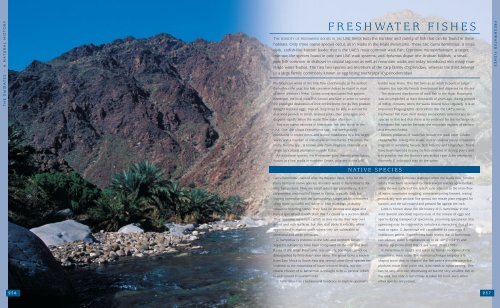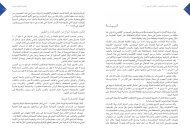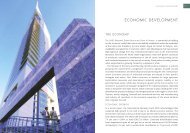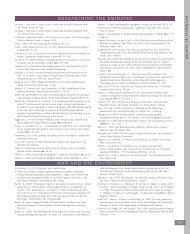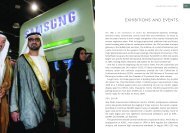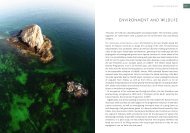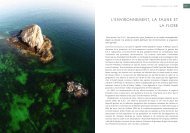FRESHWATER FISHES - UAE Interact
FRESHWATER FISHES - UAE Interact
FRESHWATER FISHES - UAE Interact
You also want an ePaper? Increase the reach of your titles
YUMPU automatically turns print PDFs into web optimized ePapers that Google loves.
T H E E M I R A T E S – A N A T U R A L H I S T O R Y<br />
No mountain wadis in the <strong>UAE</strong> flow continuously at the surface<br />
throughout the year, but fish can nevertheless be found in most<br />
of them (Feulner 1998a). Unlike some specialised fish species<br />
elsewhere, the local wadi fish cannot aestivate in order to survive<br />
the prolonged desiccation of their environment, nor do they produce<br />
drought resistant eggs. Instead, they must be able to survive for<br />
extended periods in small, isolated pools, then propagate and<br />
disperse rapidly when the wadis flow again after rain.<br />
Two non-native varieties of freshwater fish also occur in the<br />
<strong>UAE</strong>. One, the tilapia Oreochromis spp., has been actively<br />
introduced in recent times and is now established in a few larger<br />
wadis and a number of man-made environments. The other, the<br />
molly Poecilia spp., is known only from irrigation channels at a<br />
single agricultural plantation outside Dubai.<br />
An additional species, the freshwater goby Awaous aeneofuscus,<br />
occurs in a few wadis in northern Oman, adjacent to the <strong>UAE</strong><br />
<strong>FRESHWATER</strong> <strong>FISHES</strong><br />
THE SCARCITY OF <strong>FRESHWATER</strong> BODIES IN THE <strong>UAE</strong> limits both the number and variety of fish that can be found in these<br />
habitats. Only three native species occur, all in wadis in the Hajar Mountains. These are: Garra barreimiae, a small,<br />
dark, catfish-like bottom feeder that is the <strong>UAE</strong>’s most common wadi fish; Cyprinion microphthalmum, a larger,<br />
minnow-like species found in only two <strong>UAE</strong> wadi systems; and Aphanius dispar (the Arabian killifish), a small,<br />
pale fish common in shallows in coastal lagoons as well as mountain wadis and today introduced into many manmade<br />
water bodies. The first two species are members of the carp family (Cyprinidae), whereas the third belongs<br />
to a large family commonly known as egg-laying toothcarps (Cyprinodontidae).<br />
NATIVE SPECIES<br />
border near Hatta. This fish lives as an adult in pools in larger<br />
streams, but typically breeds downstream and disperses via the sea.<br />
The observed distribution of wadi fish in the Hajar Mountains<br />
was accomplished at least thousands of years ago, during periods<br />
of wetter climates, when the wadis flowed more regularly. It is an<br />
important biogeographic observation that the <strong>UAE</strong>’s native<br />
freshwater fish have their closest evolutionary relationships to<br />
species in Iran and that there is no evidence for the exchange of<br />
freshwater fish species between the mountain regions of eastern<br />
and western Arabia.<br />
Known predators of wadi fish include the wadi racer Coluber<br />
rhodorhachis, a long thin snake, and (in shallow pools) occasional<br />
migrant or wintering herons, little bitterns and kingfishers. Toads<br />
have been reported to prey on fish stranded in drying pools, and<br />
it is possible that the Burton’s saw-scaled viper Echis omanensis<br />
(formerly E. coloratus) may do the same.<br />
F R E S H W A T E R F I S H E S<br />
Garra barreimiae, named after the Buraimi oasis, is by far the<br />
most common native species. In many wadis G. barreimiae is the<br />
only fish present. They are small (adults are generally ca. 4.5–7<br />
centimetres) and mottled brown in colour, typically dark but<br />
varying somewhat with the surroundings. Larger adults sometimes<br />
show more colourful red, white or blue markings, probably<br />
related to breeding status. They feed on detritus and algae and<br />
have a specialised mouth plate that functions as a suction device.<br />
They resemble aquarium catfish as they nuzzle their way over<br />
gravel and rock surfaces, but they dart about frantically when<br />
approached in shallow pools where they are vulnerable to<br />
terrestrial and avian predators.<br />
G. barreimiae is endemic to the <strong>UAE</strong> and northern Oman.<br />
Separate subspecies have been recognised on the east and west<br />
flanks of the Hajar Mountains, respectively, but these cannot be<br />
distinguished by field observation alone. The genus Garra is known<br />
from East Africa to South Asia and several other Garra species are<br />
endemic to the mountains of south-western Arabia, but the<br />
closest relative of G. barreimiae is thought to be G. persica, which<br />
is widespread in southern Iran.<br />
G. barreimiae has a behavioural tendency to explore upstream,<br />
which probably facilitates dispersal when the wadis flow. Smaller<br />
adults have been observed to climb several metres up waterfalls,<br />
using the wet surface of the splash zone adjacent to the main flow<br />
of water, sometimes wriggling, sometimes jetting forward, resting<br />
periodically with pectoral fins spread, the mouth plate engaged for<br />
suction, and the tail twisted and pressed flat against the rock.<br />
Little is known about the life history of G. barreimiae in the<br />
wild. Several anecdotal reports exist of the release of eggs and<br />
sperm during transport of specimens, provoking speculation that<br />
spawning may be triggered by turbulence, mimicking that of a<br />
wadi in spate. G. barreimiae will cannibalise its own eggs if<br />
conditions permit. Experiments have shown that G. barreimiae<br />
can tolerate water temperatures up to ca. 40ºC (104ºF) and<br />
salinity up to one-third that of sea water (Haas 1982).<br />
G. barreimiae is caught and eaten by human residents of the<br />
mountains, even today. The normal technique employs a V-<br />
shaped stone dam to channel the fish onto a portable sieve-like<br />
platform made from palm ribs, wire mesh or nylon netting. This<br />
can be very effective, eliminating all but the very smallest fish in<br />
the area, but only G. barreimiae is taken for food, even when<br />
other species are present.<br />
256<br />
257
T H E E M I R A T E S – A N A T U R A L H I S T O R Y<br />
The Arabian killifish Aphanius dispar, is found in many<br />
<strong>UAE</strong> mountain wadis, but its primary environment<br />
is coastal lagoons (khors), where it may<br />
be the most common fish.<br />
For this reason it is known<br />
to experts as a<br />
‘secondary’ freshwater<br />
fish. It is able to<br />
tolerate a wide range of<br />
salinities, from freshwater to hypersaline. It is also able<br />
to survive at water temperatures as high as 46ºC (114ºF) (Haas<br />
1982). Such extreme temperatures can be encountered in tidal<br />
lagoons as well as in shallow mountain pools.<br />
The Arabian killifish is somewhat smaller (adults ca. 3.5–5.5<br />
centimetres) and paler than most G. barreimiae. It also swims<br />
LEFT: Garra barreimiae<br />
BELOW: Arabian killifish Aphanius dispar (female)<br />
The Arabian killifish is found around the entire Arabian Peninsula<br />
and its dispersal from one wadi system to another is undoubtedly<br />
facilitated by its ability to migrate along the seacoast. At least in<br />
some <strong>UAE</strong> wadis, however, it seems likely that it has been<br />
artificially introduced. Observations in the 1990s identified three<br />
usually marked with a row of several diffuse dark blotches along<br />
the side of the body. Larger individuals show vertically<br />
striped and variably tinted dorsal and tail fins.<br />
At breeding time, the tilapia male<br />
excavates a characteristic shallow bowl in a<br />
sandy bottom area, which he then patrols as his<br />
territory and defends against other males. In suitable<br />
areas, many territories may be established in close proximity.<br />
Mollies Poecilia spp. (formerly Mollinesia spp.) have been<br />
observed in irrigation ditches at Ruwayyah, an agricultural area<br />
outside Dubai, and may occur in similar circumstances<br />
elsewhere. They are thought to have originated from private<br />
aquaria. Mollies are native to tropical and subtropical America,<br />
but the black molly, a selectively bred variety, is a popular<br />
aquarium fish available worldwide. At Ruwayyah, mollies occur in<br />
Molly Poecilia spp. (female)<br />
three colour varieties: black (the commercial variety), pale beige<br />
(considered to be the original wild colour) and mottled black-andbeige.<br />
This phenomenon represents a reversion of the aquarium<br />
stock to the original wild colour due to indiscriminate breeding.<br />
F R E S H W A T E R F I S H E S<br />
higher in the water column and often ‘hovers’ characteristically<br />
with the tail curved slightly to one side. Adults show marked sexual<br />
wadis in which A. dispar was, anomalously, the only fish present<br />
(Feulner 1998a). Two of these were subsequently found to dry up<br />
OTHER SPECIES POSSIBLY PRESENT<br />
dimorphism. Females are mottled golden-brown with numerous<br />
dark, vertical, zebra-like stripes; males are pale and faintly whitestippled<br />
but the tail fin bears two to three dark vertical bands. In<br />
breeding colour the lips and fins of the male are vivid blue-white<br />
and, when displaying, the tail is fluttered like a matador’s cape.<br />
The Arabian killifish is a surface feeder by design, but in the wadi<br />
environment it is highly opportunistic. It can subsist on algae, but it<br />
entirely during prolonged drought, eliminating all fish.<br />
Cyprinion microphthalmum is the largest but least common of the<br />
<strong>UAE</strong>’s native species. Within the <strong>UAE</strong>, it is found only at Hatta<br />
and Hadf, and only in larger pools, but it is present throughout the<br />
mountains of northern Oman, and in Iran, Pakistan and Afghanistan.<br />
C. microphthalmum is a streamlined mid-water swimmer. Its<br />
mouth and lips are specialised for scraping algae from rock surfaces,<br />
The freshwater goby Awaous aeneofuscus, has been found in<br />
northern Oman in wadis adjacent to the <strong>UAE</strong> border near Hatta<br />
(Feulner and Cunningham 2000). Most gobies are sedentary marine<br />
fish inhabiting shallow-water environments and sheltering in<br />
burrows or crevices. Some, however, live primarily in freshwater<br />
rivers and streams. Awaous aeneofuscus is one of the latter and is<br />
found in Indian Ocean tributaries from South Africa to Pakistan,<br />
spring tides and after heavy seasonal rains. The goby population<br />
near Hatta nevertheless seems to have maintained itself in situ<br />
for a number of years without access to the sea.<br />
It is probably inevitable that additional introduced fish species<br />
will be found from time to time at discrete permanent freshwater<br />
sites, particularly in agricultural ponds and dammed lakes.<br />
Aquarium fish, such as guppies Poecilia reticulata and platties<br />
takes live food when available and also feeds on debris on the wadi<br />
but it will also take live food such as mosquito larvae and small<br />
in a variety of habitats. A. aeneofuscus could possibly be found<br />
Xiphophorus maculatus, in addition to the mollies mentioned<br />
bed. It is also an efficient predator of mosquito larvae. One study<br />
crustaceans, when available. Adults are recognisable by their size<br />
from time to time in the larger East Coast wadis of the <strong>UAE</strong>, such<br />
above, have been released into spring-fed drainage systems in<br />
reported an average consumption of 96 larvae per fish per day, in<br />
(up to ca.12 centimetres) and their large, transparent, deeply forked<br />
as Wadi Wurayyah or Wadi Zikt, although the recent construction<br />
eastern Saudi Arabia and have apparently persisted (Ross 1985).<br />
the presence of abundant alternative foods (Haas 1982).<br />
tail. They are grey-brown dorsally, sometimes slightly mottled, with<br />
of major dams in those wadis diminishes that possibility.<br />
All of the foregoing species are members of the live-bearing<br />
For this reason A. dispar has been introduced for<br />
large, distinct scales. When seen from the side, as sometimes<br />
A. aeneofuscus is a sedentary, omnivorous bottom-dweller that<br />
toothcarp family (Poecilidae) and are prolific in captivity. Another<br />
mosquito control into<br />
happens when feeding, they are a striking<br />
can exceed 20 centimetres in length. The elongated body is<br />
member of the same family is Gambusia affinis, a New World<br />
various man-made<br />
silvery white that can reflect like<br />
mottled grey-brown with diffuse, yellow-buff transverse bands<br />
species that has been widely introduced elsewhere to control<br />
bodies of water in<br />
the flash of a knife blade.<br />
across the back. In open sand or gravel, it can take cover by<br />
mosquitoes, but often to the severe detriment of the native fish<br />
the <strong>UAE</strong>, including<br />
In breeding colour<br />
rapidly burying itself. Reproduction by A. aeneofuscus has never<br />
fauna, as in Iran. Fortunately, the high summer temperatures of<br />
cisterns, agricultural<br />
they darken and the<br />
been observed, but is thought to be similar to other large species<br />
freshwater bodies in the Hajar Mountains, and the extreme<br />
runoff channels,<br />
lips, gill areas and pectoral<br />
of Awaous, in which adults move downstream to estuaries to<br />
irregularity of their hydrologic regimes, may protect against the<br />
bulldozed ponds and<br />
fins become a vivid pale blue.<br />
breed, the eggs becoming part of the oceanic plankton community<br />
successful introduction of G. affinis in the wild in the <strong>UAE</strong>.<br />
water tanks. It is able to reproduce<br />
Immature fish are mottled golden-brown<br />
for an unknown period of time. Fry return to streams during<br />
Gary Feulner<br />
successfully in all of these environments.<br />
and can be difficult to distinguish from juvenile G. barreimiae.<br />
INTRODUCED SPECIES<br />
Freshwater goby Awaous aeneofuscus<br />
Tilapia are a sub-group of the very large and highly diversified<br />
Cichlid family of fish (Cichlidae). The name tilapia refers to several<br />
similar species in the related genera Oreochromis and Tilapia.<br />
Tilapia are omnivores and they have been introduced throughout<br />
Arabia in recent years to freshwater bodies of all kinds for algae,<br />
weed and mosquito control. Some are now bred locally.<br />
Tilapia are notoriously voracious, hardy and prolific species native<br />
to African rivers that vary seasonally, predisposing the fish to be<br />
able to tolerate considerable fluctuations in temperature, salinity,<br />
water quality and food resources. Tilapia are also much larger than<br />
the <strong>UAE</strong>’s native wadi fish (potentially exceeding 20 centimetres),<br />
making them not only formidable competitors but also potential<br />
predators. As a result, there is reason for concern that the<br />
introduction of tilapia will adversely affect native fish populations.<br />
Field identification of individual tilapia species is difficult. The<br />
species present in the <strong>UAE</strong> have not been confirmed, but probably<br />
include Oreochromis niloticus and O. mossambicus. The variety most<br />
commonly seen in wadi environments is a pale beige colour,<br />
258<br />
259


